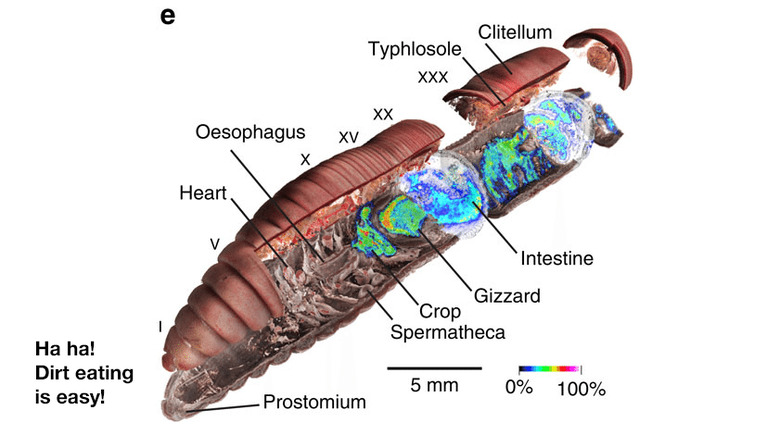Worms Defense Against Plants Has Big Implications For Science
A unique compound of chemicals has been discovered in the guts of earthworms in a study on how these creatures break down toxins in soil. This study centered on polyphenols, chemical compounds produced by plants that contain phenol, aka carbolic acid. Soil is polyphenol-rich, meaning earthworms – who eat and process soil – need to cope with a "high-polyphenol diet." They eat toxins, how do they do it? As it turns out, earthworms work with a compound scientists are calling "drilodefensin", able to metabolize these toxins effectively.
Drilodefensins are a class of surface-active metabolites that exist within the gut of the earthworm. In the image below you'll see where these metabolites exist most commonly inside the earthworm's body.

ABOVE: Drilodefensin (compound 1) distribution in an earthworm, schematic multi-modal three-dimensional model based on micro-computed tomography integrated with IMS data. The colour scale in [the image above] represents the relative abundance of m/z 259.1004. Labelling: ep, epithelium; cm, circular muscle; lm, longitudinal muscle; ge, gut (intestinal) epithelium; gl, gut lumen; np, nephridial tubule profiles (in coelomic cavity); ty, typhlosole fold. doi:10.1038/ncomms8869
In this study, scientists have observed that as polyphenol concentration increases in an earthworm's diet, so too does the drilodefensin in their systems. This effect occurs in both laboratory and field populations of earthworms.
The abstract of the paper published on this subject this week asserts that these scientists have "identified the key mechanism for adaptation to a dietary challenge in an animal group that has a major role in organic matter recycling in soils worldwide."
Earthworms are responsible for turning over >1010 ton of plant carbon per year, and these metabolites "may play a key ecological role" in the turnover of soil vital to the circle of life on Earth.
Much like the cockroach is studied for its abilities to adapt to changing environments, so too will drilodefensin be studied for its ability to "give earthworms the ability to populate many habitats."
We've reached out to the lead authors of this study to learn more about the implications of the discovery of drilodefensin.
For more information, see the paper "Unique metabolites protect earthworms against plant polyphenols" by authors Manuel Liebeke, Nicole Strittmatter, Sarah Fearn, A. John Morgan, Peter Kille, Jens Fuchser, David Wallis, Vitalii Palchykov, Jeremy Robertson, Elma Lahive, David J. Spurgeon, David McPhail, Zoltán Takáts, and Jacob G. Bundy. This paper was published in the scientific journal Nature under code doi:10.1038/ncomms8869.
